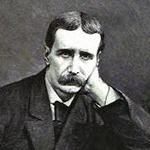
Briton Riviere was best known as an animal painter, but he also painted some striking genre and history paintings, often including animals. Born in London in 1840, he came from an artistic family of Huguenot descent: his grandfather was a student at the Royal Academy Schools, as was his father, William Riviere, who went on to become a drawing-master at Cheltenham College, Gloucestershire. Young Briton, who had already started sketching animals at London Zoo, and in 1851 exhibited oil paintings of kittens at the British Institution, was educated at Cheltenham from 1851 to 1859. In 1857, when still at school, he had three paintings accepted by the Royal Academy ("Death of Mr Briton Riviere").
At this point his father moved to Oxford, where he established art as an area of study within the university. Having moved there with his family in 1859, Riviere went on to take his BA and MA degrees at St Mary Hall, Oxford. His connection with St Mary's continued and stood him in good stead: he would be granted the honorary degree of DCL (Doctor of Civil Law) in 1891, and later still an honorary fellowship at Oriel College, with which St Mary Hall was associated. William Fenn believed that "to the cultivation of his mind is due, in great part, the completeness and refinement which, amongst other qualities, especially distinguish his work".
As a young man, Riviere came under the influence of the Pre-Raphaelites and Millais. But after his promising start, success proved elusive, and he had to diversify by taking on illustrative work — not that this was necessarily a step down, since so many important artists at this time were producing illustrations. However, in his case it included making decorative initials for Punch, which was perhaps not what he had expected to be doing. Applying himself to animal painting, and studying with the Scottish painters John Pettie and Sir William Quiller Orchardson, both helped him to firmer ground: "A sequence of animal paintings exhibited at the Royal Academy assured his growing fame" (Reynolds), particularly because they were often engraved. In 1878 he was elected Associate of the Royal Academy, and in 1880 became a full Academician. After Millais' death in 1896, he only just missed being voted president of the Academy (Sir Edward Poynter won the vote by a narrow margin), although, as Simon Reynolds points out, this was an honour that he would probably not have enjoyed, since he was of "retiring disposition." The same point was made in his Times obituary. Later on, too, his failing eyesight would have been a problem.
As an animal-painter, Riviere "tended to imbue his animals with para-human character", and did not always escape sentimentality — although he could be humorous as well. While animals did generally feature in his works, his skills were not at all limited to them. At his best, he could produce "a most happy combination of classic lore and animal painting" (Fenn 145), and in later years he became interested in the idea of evolution and was drawn to create wild landscapes like Beyond Man's Footsteps, very different from his popular scenes of children with their pets.